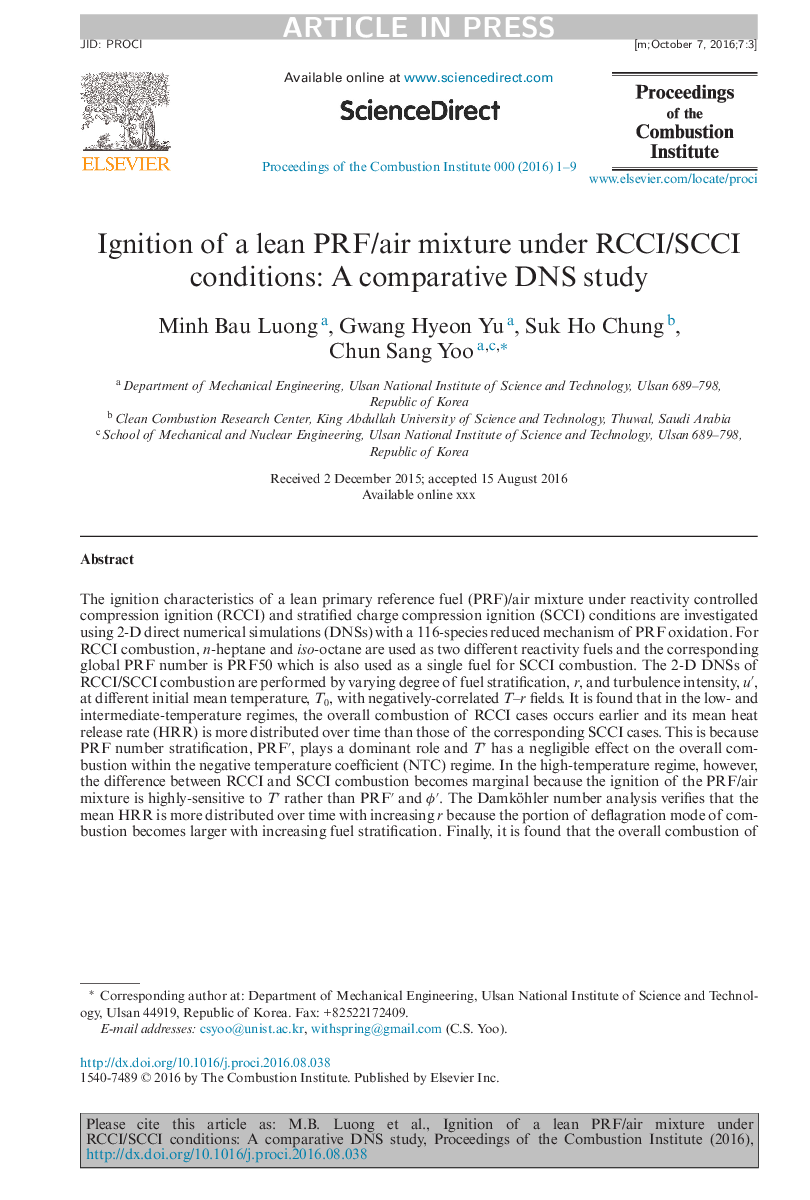| کد مقاله | کد نشریه | سال انتشار | مقاله انگلیسی | نسخه تمام متن |
|---|---|---|---|---|
| 4915418 | 1427915 | 2017 | 9 صفحه PDF | دانلود رایگان |
عنوان انگلیسی مقاله ISI
Ignition of a lean PRF/air mixture under RCCI/SCCI conditions: A comparative DNS study
دانلود مقاله + سفارش ترجمه
دانلود مقاله ISI انگلیسی
رایگان برای ایرانیان
کلمات کلیدی
موضوعات مرتبط
مهندسی و علوم پایه
مهندسی شیمی
مهندسی شیمی (عمومی)
پیش نمایش صفحه اول مقاله

چکیده انگلیسی
The ignition characteristics of a lean primary reference fuel (PRF)/air mixture under reactivity controlled compression ignition (RCCI) and stratified charge compression ignition (SCCI) conditions are investigated using 2-D direct numerical simulations (DNSs) with a 116-species reduced mechanism of PRF oxidation. For RCCI combustion, n-heptane and iso-octane are used as two different reactivity fuels and the corresponding global PRF number is PRF50 which is also used as a single fuel for SCCI combustion. The 2-D DNSs of RCCI/SCCI combustion are performed by varying degree of fuel stratification, r, and turbulence intensity, uâ², at different initial mean temperature, T0, with negatively-correlated T-r fields. It is found that in the low- and intermediate-temperature regimes, the overall combustion of RCCI cases occurs earlier and its mean heat release rate (HRR) is more distributed over time than those of the corresponding SCCI cases. This is because PRF number stratification, PRFâ², plays a dominant role and Tâ² has a negligible effect on the overall combustion within the negative temperature coefficient (NTC) regime. In the high-temperature regime, however, the difference between RCCI and SCCI combustion becomes marginal because the ignition of the PRF/air mixture is highly-sensitive to Tâ² rather than PRFâ² and Ïâ². The Damköhler number analysis verifies that the mean HRR is more distributed over time with increasing r because the portion of deflagration mode of combustion becomes larger with increasing fuel stratification. Finally, it is found that the overall combustion of both RCCI and SCCI cases becomes more like the 0-D ignition with increasing uâ² due to the homogenization of initial mixture by turbulent mixing.
ناشر
Database: Elsevier - ScienceDirect (ساینس دایرکت)
Journal: Proceedings of the Combustion Institute - Volume 36, Issue 3, 2017, Pages 3623-3631
Journal: Proceedings of the Combustion Institute - Volume 36, Issue 3, 2017, Pages 3623-3631
نویسندگان
Minh Bau Luong, Gwang Hyeon Yu, Suk Ho Chung, Chun Sang Yoo,